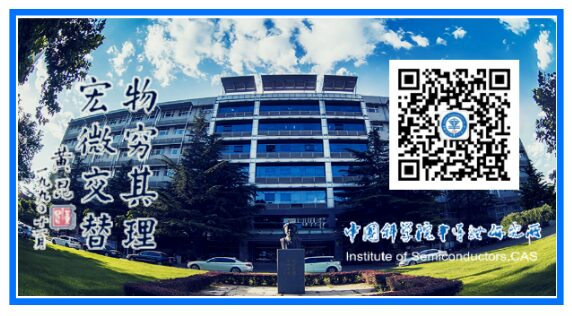
Source: TechSugar
Original Author: Liu Hong
The TMR (Tunneling Magnetoresistance) sensor is a type of sensor that utilizes quantum phenomena to provide performance advantages over existing sensors, making it a potential replacement for mainstream Hall effect sensors and similar products.
What is a Quantum Sensor?
Sensors are used to collect data on a range of phenomena to measure the physical characteristics of devices, acting as converters that output measurable electrical signals. There are many characteristics that can be measured using sensors, with the most relevant to the quantum sensor market being time, motion, gravity, magnetic fields, electric currents, and photons.
The operation of quantum sensors relies on quantum phenomena, significantly enhancing their sensitivity compared to the sensors they replace, thereby increasing their value or enabling the measurement of other characteristics that cannot be obtained otherwise. In most cases, the utilization of quantum phenomena provides a higher sensitivity advantage than classical alternatives. However, in some instances, performance improvements may come at the expense of power consumption, size, or remote sensing capabilities.
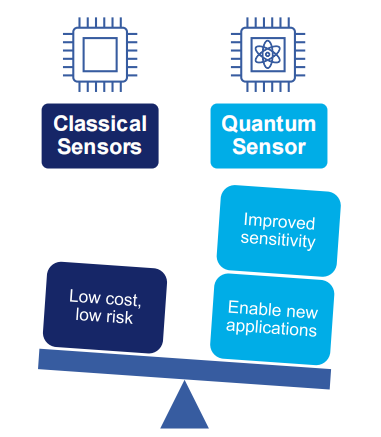
Advantages of Quantum Sensors
What are TMR Sensors?
Although IDTechEx classifies TMR sensors as quantum sensors, strictly speaking, TMR sensors are not quantum sensors; however, they utilize the quantum tunneling effect (a quantum mechanical phenomenon).
TMR sensors consist of thin ferromagnetic layers and nanoscale insulators, using quantum tunneling for high-sensitivity magnetic field measurements. Thanks to quantum mechanics, the probability of electrons tunneling through these layers strongly depends on magnetic and electric fields. TMR sensors can be integrated into circuits, causing the circuit to exhibit easily measurable voltage or resistance changes, detecting magnetic fields hundreds of times smaller than existing sensors.
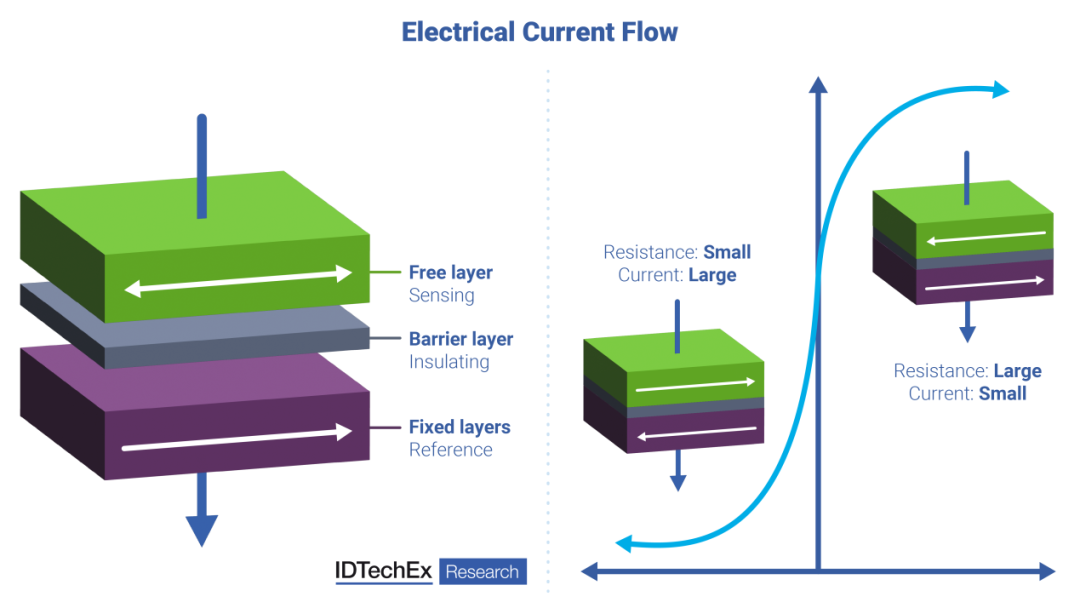
How TMR Sensors Work
Compared to GMR (Giant Magnetoresistance) sensors and AMR (Anisotropic Magnetoresistance) sensors, TMR sensors are more sensitive to the direction of external magnetic fields and respond faster, making them suitable for applications requiring high sensitivity and quick response, such as position and speed detection.

Comparison of TMR Output Response with GMR and AMR
In fact, sensitivity is not the only important parameter in the sensor market. Optimizing size, weight, power, and cost (SWAP-C) is also crucial. Compared to Hall sensors, TMR sensors can reduce power consumption, which is a key attraction for users. Particularly, Internet of Things (IoT) devices require the ability to operate longer, relentlessly pursuing low power consumption.

Key Feature Comparison of Miniaturized Magnetic Field Sensors
TMR sensors have a relatively simple structure, which aids in achieving highly optimized SWAP-C and can be manufactured using CMOS technology in existing semiconductor foundries. Their miniaturization not only competes with more mature solutions but often has advantages in many cases.
Furthermore, many other quantum sensing technologies are also being developed, including magnetic field sensors, clocks, gravimeters, gyroscopes, and photodetectors. These technologies have the potential to improve sensitivity by several orders of magnitude, potentially disrupting the existing sensor market.
However, next-generation quantum sensors still face challenges, including the complexity of the components and infrastructure required for solutions based on entanglement and superposition, which are far more complicated than tunneling. Vapor batteries, lasers, nitrogen vacancy centers, and others remain high-value technical challenges that the quantum technology industry needs to address.
Advantages of TMR Sensor Application Diversity
TMR sensors have applications in multiple vertical industries such as wake-up, angle and position sensing, and remote current detection. Many wearable and medical devices rely on wake-up functionality, including continuous glucose monitors for diabetes management and sealed digital pills; remote sensing and temperature robustness also provide enhanced safety for monitoring electric vehicles and solar systems. As for its position and angle detection, there are virtually limitless applications, with significant value in wind turbine power optimization, robotics, and factory optimization.
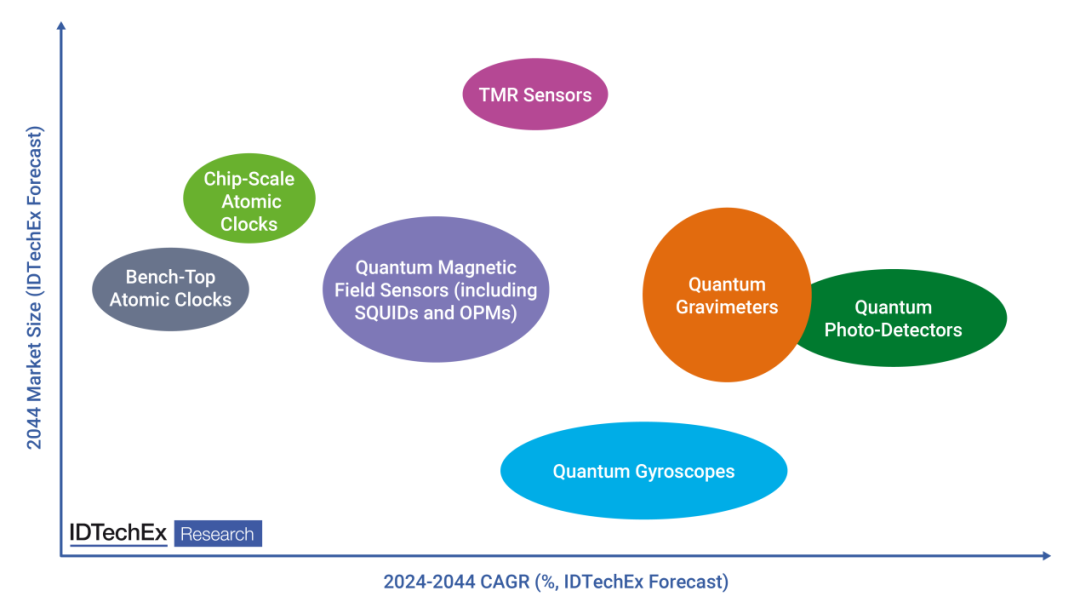
Relationship Between Market Size and Compound Annual Growth Rate
Why Are Quantum Sensors So Attractive?
Quantum sensors are expected to unlock new applications by significantly improving sensitivity. Currently, there are over a dozen quantum sensing technologies, including various types of atomic clocks and magnetic field sensors, applied in electric vehicles, GPS navigation, medical imaging, and quantum computing.
The key conclusion drawn from assessing these market sizes is that TMR sensors have large-scale market applications in both automobiles and wearable devices, forming a cumulative potential market of hundreds of billions over a long period. It represents a low-value, high-capacity market with a high compound annual growth rate and market size.
The next largest potential market could be gyroscopes and atomic clocks, both of which can be used for navigation and timing. Gravimeters and image sensors have very specialized applications, expected to be primarily used for underground mapping and quantum computing, respectively. Of course, the scale of these markets depends on pricing and commercial readiness timelines.
Why Will Navigation Become the Mass Market for Quantum Sensors?
So far, the most common method for obtaining accurate positioning and local time is through GNSS (Global Navigation Satellite System) data, such as the U.S. military’s GPS (Global Positioning System). However, in certain environments, obtaining GPS data can be restricted due to high terrain blocking signals or third-party spoofing, thus increasing the pressure for precision navigation systems to maintain reliability in GPS-denied environments.
Autonomous vehicles are a significant example where a few centimeters of navigation accuracy are crucial, and the life risks associated with system errors are a major danger. Additionally, in densely populated urban environments, many smartphone and wearable device users struggle to navigate using mapping applications due to GPS signal loss.
Continuing navigation without triangulation relies on accurate measurements of distance traveled, direction, speed, and time. Existing motion sensors, gyroscopes, and local oscillators (clocks) lack the precision needed for accurate navigation; electronic devices increasingly depend on receiving time information from satellites.
Quantum sensors for position and motion (such as gyroscopes and accelerometers) and time (atomic clocks) can provide local access to precise inertial navigation systems without relying on GNSS. Thus far, many quantum sensing technologies remain too large or expensive to meet the mass market’s navigation needs. However, with the increasing demand for autonomous vehicles, smartphones, and wearable devices, this technology is expected to further miniaturize and optimize over the next decade. Therefore, navigation is the most likely mass market application for quantum sensing.

Precision Clocks Play a Vital Role in Precision Navigation and Timing Technologies in GNSS-Denied Environments
The Future of Quantum Sensing Technology
Currently, major quantum sensing technologies under development include atomic clocks, magnetic field sensors, gyroscopes, gravimeters, and image sensors. Generally, larger market sizes require sensors to have optimized SWaP-C.
At present, the main challenge facing the quantum sensing industry is miniaturizing laboratory or desktop quantum sensing devices so that they can compete with existing devices in the mass market.
The table below illustrates the approximate technology readiness levels associated with each market for technology development in niche and mass market applications by 2024. For instance, some chip-level atomic clocks can be used for last-mile navigation in aerospace, but they remain too expensive, large, and unstable for consumer electronics.

Quantum Sensing Technology Readiness Levels
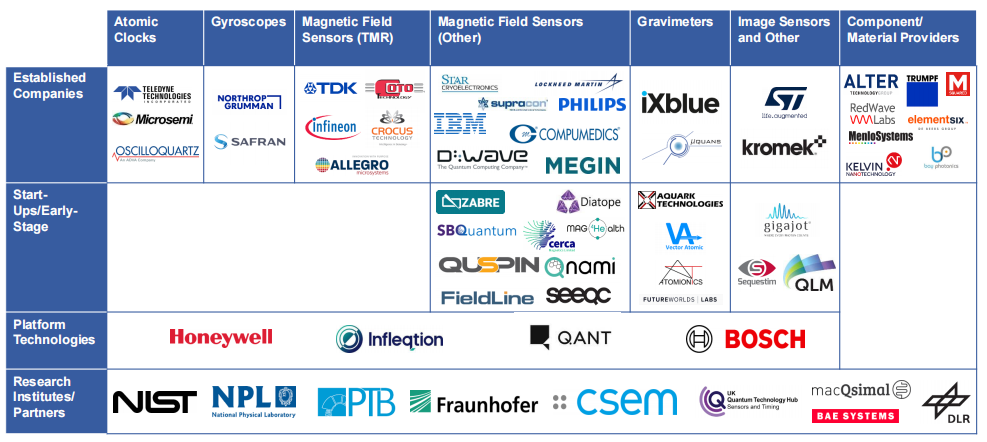
Market Map of the Quantum Sensor Industry
Regardless, quantum sensor technology will be widely applied. Currently, millions of chip-level TMR sensors have entered the automotive industry for remote current detection, while biogmagnetic imaging using optical pump magnetometers is still in its early stages.
There are indications that atomic clocks and quantum gyroscopes will become the precise navigation and timing technologies adopted by the aerospace, automotive, financial, and even consumer electronics markets in the future.
Through high sensitivity and optimized size, weight, and power consumption, TMR sensors will add commercial value across multiple industries. This technology has become an example of leveraging quantum effects to disrupt the classical sensor market.
END
The reproduced content only represents the author’s views
It does not represent the position of the Institute of Semiconductors, Chinese Academy of Sciences
Editor:Qian Niao
Editor-in-Chief: Jiang Yu
Submission Email: [email protected]
1. The Semiconductor Institute has made progress in the study of bionic covering neuron models and learning methods
2. The Semiconductor Institute has made significant progress in inverted structure perovskite solar cells
3. A review of the development history of semiconductors in New China – “Through the rugged road for decades, the light boat has passed ten thousand mountains”
4. What exactly is 7nm for chips?
5. Silicon-based integrated optical quantum chip technology
6.How unusual is the quantum anomalous Hall effect? It may bring about the next revolution in information technology!
